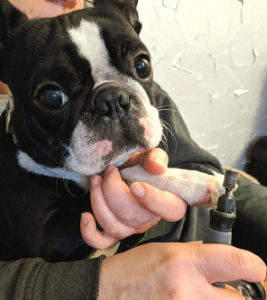Quite a few years ago we were privileged to have a “behind the scenes” tour of the Lincoln Park Zoo’s Lion House. A dog friend of ours was a zookeeper and it was a once-in-a-lifetime opportunity for animal lovers like us.
We were amazed to be within inches of gorgeous lions, tigers, and bobcats in their off-exhibit area where all of the animal husbandry behaviors were performed. Lately, we’ve seen more examples of animals, both large and small, wild and domestic, being trained to consent in their own care.
The example we’re most familiar with is dolphins. One of our favorite places on the planet is the Dolphin Research Center in Grassy Key, Florida. DRC is actively involved in the “research” part of its name, creatively studying dolphin cognition with training games. One of their most intriguing studies involved recognition of identical objects. We were thrilled to actually participate in one of the training games. Another amazing opportunity.
How does it apply to dogs?
Among the most important training games played at DRC are those practicing animal husbandry. If a pregnant dolphin doesn’t want to stay still for an ultrasound, she can just swim away. Dolphins not trained to let someone draw blood from tail flukes? It’s not going to happen. When an older dolphin needs a nebulizer to get his medication, he needs to understand that the weird object perched on his head is okay. e can just float there while it’s happening.
Recently there’s been growth in the “Fear Free” movement in veterinary care. We’ve seen expansion in the idea of getting dogs (and cats) to consent to treatment and grooming procedures. This can range from getting eyes, ears, and teeth examined, to vaccinations, and nail trimming.
Those of us with small dogs can “make” our dogs comply. But it’s certainly a goal to make it easier on everyone, both people and dogs. We know that the pandemic has made veterinary appointments difficult to come by. And it’s particularly hard on our pets when we can’t accompany them. But there are things you can do to help your dog.
Getting consent in dog care
A terrific local trainer has the people in her classes bring shirts and socks to class for the dogs to wear. Aside from adorable, it’s a painless way to teach dogs to put their heads into something, and allow their paws to be touched. To a dog, there’s probably not a big difference between putting his head into a shirt, or a “cone of shame.” If your dog breaks a nail, as Golly did a couple of times, they’ll be more likely to leave the bandaging alone if they’re used to something being on their paws.
Similarly, we can all make a game out of touching the dog’s muzzle to look at their teeth. Or shining a flashlight into their ears. These are little things you can do to help your dog understand that nothing bad will happen with grooming or exams.
Make it treat time
People are using “lick mats” spread with a soft treat like peanut butter to occupy their dogs during bathing. It’s a great idea – turning something that could be stressful into treat time. One trainer teaches her dog to put its chin on a Post-it Note. That won’t work in the tub, but she did use it on the back of a chair while she administered a vaccine.
Dogs are smart, adaptable beings. If they know what’s happening, chances are they’ll trust people that no harm will come. One of our most important lessons to our training students is “never lie to your dog.” Don’t try to trick them. Never fool them. Teach them to know what’s coming and, chances are, they’ll be fine with it.









